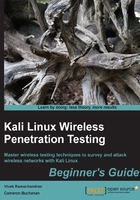
Time for action – experimenting with your adapter
Follow these instructions carefully:
- Reboot your computer and do not connect your adapter to it yet.
- Once logged in, monitor the kernel messages using the
tailcommand:
Insert the adapter, and you should see something that resembles the following screenshot. This shows the default regulatory settings applied to your card:

- Let's assume that you are based in the US. To change your regulatory domain to the US, we issue the command
iw reg set USin a new terminal:
If the command is successful, we get an output such as the one in the following screenshot in the terminal where we monitoring
/var/log/messages:
- Now try changing the card to channel 11; it will work. But, when you try changing it to channel 12, you get an error. This is because channel 12, cannot be used in the US.

- The same applies for power levels. The US only allows a maximum of 27 dBm (500 milliwatts); thus even though my adapter has an advertised power of 1 Watt (30 dBm), we cannot set the card to the maximum transmit power:

- However, if we were in Bolivia, then we could transmit at a power of 1 Watt as this is allowed there. As we can see, once we set the regulatory domain to Bolivia—
iw reg set BO—we can change the card power to 30DMB or 1 Watt. We can also use channel 12 in Bolivia, which was disallowed in the US:
What just happened?
Every country has its own regulations for the use of the unlicensed wireless band. When we set our regulatory domain to a specific country, our card will obey the allowed channels and power levels specified. However, it is easy to change the regulatory domain of the card and force it to work on disallowed channels and to transmit at a power level that is greater than allowed.
Have a go hero – exploring regulatory domains
Look at the various parameters you can set such as channel, power, regulatory domains etc. using the iw series of commands on Kali. This should give you a firm understanding of how to configure your card when you are in various countries and require to change your card settings.
Pop quiz – WLAN packet sniffing and injection
Q1. Which frame types are responsible for authentication in WLANs?
- Control
- Management
- Data
- QoS
Q2. What is the name of the second monitor mode interface that can be created on wlan0 using airmon-ng?
- Mon0
- Mon1
- 1Mon
- Monb
Q3. What is the filter expression to view all non-beacon frames in Wireshark?
- !(wlan.fc.type_subtype == 0x08)
- wlan.fc.type_subtype == 0x08
- (no beacon)
- Wlan.fc.type == 0x08